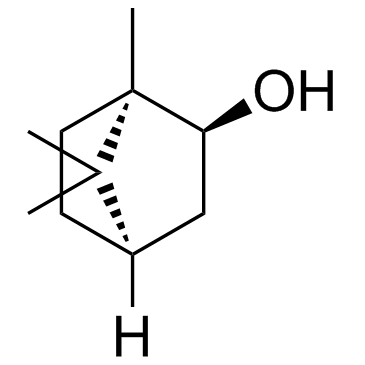Home
Products
(+)-Borneol



| Product Name | (+)-Borneol |
| Price: | $17 / 20mg |
| Catalog No.: | CN09598 |
| CAS No.: | 464-43-7 |
| Molecular Formula: | C10H18O |
| Molecular Weight: | 154.2 g/mol |
| Purity: | >=98% |
| Type of Compound: | Monoterpenoids |
| Physical Desc.: | Powder |
| Source: | The fruits of Cnidium monnieri |
| Solvent: | Chloroform, Dichloromethane, Ethyl Acetate, DMSO, Acetone, etc. |
| SMILES: | O[C@H]1C[C@@H]2C([C@@]1(C)CC2)(C)C |
| Contact us | |
|---|---|
| First Name: | |
| Last Name: | |
| E-mail: | |
| Question: | |
| Description | (+)-Borneol (d-Borneol) is a natural bicyclic monoterpene used for analgesia and anesthesia in traditional Chinese medicine; enhances GABA receptor activity with an EC50 of 248 μM. |
| Target | EC50: 248 μM (GABA receptor)[1] |
| In Vitro | (+)-Borneol is present in the essential oils of numerous medicinal plants, including valerian (Valeriana officinalis), chamomile (Matricaria chamomilla) and lavender (Lavandula officinalis). Extracts of these plants are used traditionally to relieve anxiety, restlessness and insomnia. (+)-Borneol is found to have a highly efficacious positive modulating action at GABAA receptors. (+)-Borneol enhances the action of low concentrations of GABA by more than 1000% (EC50=248 μM)[1]. |
| In Vivo | (+)-Borneol has remarkable anti-hyperalgesic effects on neuropathic and inflammatory pain in animal models. Both oral administration (125, 250 or 500 mg/kg) and intrathecal injection (i.t.) (15, 30 and 60 μg) of (+)-Borneol reduce mechanical hypersensitivity dose-dependently in SNL and CFA models. The antihyperalgesic effects of (+)-Borneol are abolished by a selective GABAA receptor (GABAAR) antagonist bicuculline. (+)-Borneol (500 mg/kg, p.o. or 60 μg, i.t.) does not influence motor function[2]. After per oral application, (+)-Borneol is absorbed rapidly into the brain and could be determined 5 min after dosing. The maximal brain concentration (86.52 μg/g) is reached after 1 h post-dosing. (+)-Borneol could affect the contents of AA neurotransmitters in mice brain and the change in excitatory ratio leads to borneol's double side effects on the central nervous system[3]. |
| Animal Admin | Mice: Inflammatory pain is induced by injection of Complete Freund's adjuvant (CFA, 1 mg/mL). Ten min later mice are treated with (+)-Borneol (125, 250, 500 mg/kg) or vehicle. Mechanical hypersensitivity is then measured[2]. |
| Density | 1.0±0.1 g/cm3 |
| Boiling Point | 212.0±0.0 °C at 760 mmHg |
| Flash Point | 80.7±10.9 °C |
| Exact Mass | 154.135757 |
| PSA | 20.23000 |
| LogP | 2.71 |
| Vapour Pressure | 0.0±0.9 mmHg at 25°C |